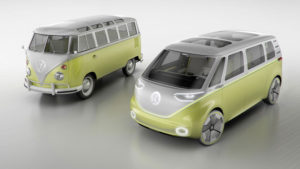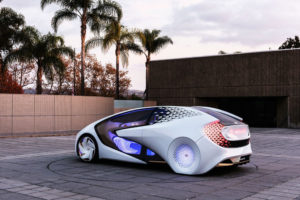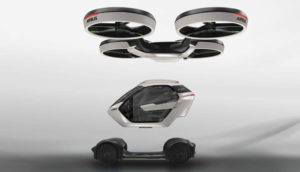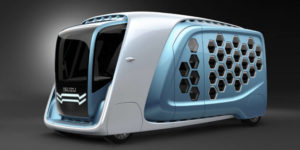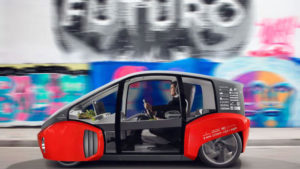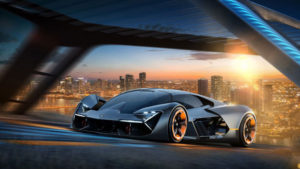While they’re not here yet (although hopefully soon) these upcoming concept cars are pushing the envelope when it comes to the advancement of technology and science. From gardens inside your vehicle to getting your car picked up by a drone, there are some truly innovative designs on the horizon. Maybe one day people looking for the best car comparison Canada has to offer (that would be, ahem, Bidz Auto) will be able to find these cars here!
Volkswagen ID Buzz (2022)
Credit: Volkswagen
Ah, the microbus, a beloved classic that lives on as a symbol to the counterculture movement. Unfortunately the last production of these vans ended in December 2013, but thankfully there’s a reimagining on the horizon: The Volkswagen ID Buzz.
The ID part comes from the onboard AI (named ID) that Volkswagen wants to showcase. It will be able to detect who the driver is, their music choices, and how they like their seat adjusted among other internal settings.
Like many new cars, the ID Buzz will be fully electric with an effective range of about 435 km and self-driving due to its cleverly placed sensors and will collect real-time traffic data to aid in its autonomous efforts. The steering wheel can also retract while the car is autonomous, but can easily be brought back out by the driver pressing on the gas pedal or brake.
Due to its intelligent design, the battery is stored in the undercarriage of the car leaving more space in the interior for friends, family, and good times.
Toyota Concept-i (Around 2020)
Credit: Toyota
While some companies are attempting to make straight jumps to self-driving cars, Toyota’s Concept-i focuses on the driving experience instead.
Like the ID Buzz, the Concept-i will also have an AI (called Yui) that will learn more about you and your preferences over time. One of the most intriguing aspects of this AI is that it will be able to read your emotions and help you retain focus while driving like playing music or talking to you.
The Concept-i is designed to be safe, while also making the driving experience more fun (the car can wink at you for example). The interior is meant to be minimalistic, but does feature a panoramic sunroof and scissor doors. It won’t have any touch screens, but will have a large head-up display on the dash giving you the most relevant information and even providing real-time GPS navigation on the windshield.
Airbus Pop.Up (Unknown)
Credit: Airbus
Probably one of the most wild and outlandish models on our list, the Airbus Pop.Up is meant to be a merging of car and plane without explicitly being a flying car. Essentially, the self-driving “car” parks, a large drone is sent out to pick up your car “pod,” it attaches to the roof of your pod and you fly autonomously to your destination.
The car section is battery-powered and only has two seats and can drive about 100 km on a single charge; it’s unclear if the drone section would also be electric.
This might be the closest we’ve come to flying cars, but with so many design challenges (i.e. what happens if your pod detaches?) it’s unclear if this project would ever get off the ground (pun intended).
Isuzu Motors FD-SI (Unknown)
Credit: Isuzu Motors
While many companies are focused on the consumer side or getting around, the FD-SI takes a look at improving delivery trucks. No, that honeycombed design isn’t just for looks, that’s also how items are stored in the back allowing for more carrying capacity.
The design is a little lonely with only a single driver seat occupying the very rectangular cab, but every part of the driver’s area is meant to make things more centralized while driving. It features a U-shaped steering wheel, the large glass windshield gives an open view of the road, and there is a small heads up display on the dash providing the driver with the most important information.
It hasn’t been disclosed how the vehicle would be powered, but it’s a safe bet to guess it’ll operate on fuel cells or an electric motor.
Rinspeed Oasis (Unknown)
Credit: Rinspeed
Designed to be part of a ride-share network the Oasis, the car functionality is based around an app. In the app you can see what cars are available to you, and allows you to choose the passenger you’re most keen on similar to swiping right on Tinder. The car will then autonomously navigate itself to pick you up at your current location.
The name “Oasis” part comes from the ability to grow a small garden, complete with bonsai trees, on the windshield.
The car also comes with a huge curved 5k display that can not only alert you of obstacles, but also plays movies and other media.
The steering wheel can fold down when in self-driving mode to allow for a keyboard attachment complete with cup holders.
With all these features the energy demands are somewhat substantial, which is why the Oasis also has solar panels on the roof to collect more energy.
More computer than car, it’s hard to say if this would ever be put into production, but if it did it would one of the most luxurious taxis to get around in.
Lamborghini Terzo Millennio (Never)
Credit: Lamborghini
You know we couldn’t round out the list without a supercar, and the Terzo Millennio (meaning third millenium) is a fantastic example of the best and brightest designing an outstanding vehicle. While this car is never going to go into production, it does serve as a platform to design both future cars and supercars.
The first all-electric sports car by Lamborghini, it powers the car not through batteries, but supercapacitors that are significantly better at taking in and discharging energy than regular batteries. However, they can’t hold large amounts of energy for long periods of time so the technology still has a ways to go.
Because the supercapacitors are worked into the carbon body panels, the car can heal itself… sort of. The supercapacitors change the energy flow of the car to prevent body cracks, but it won’t magically repair large dents if you bump into something while parking.
The car is meant more as a driving instructor for racetracks to give drivers an idea of how to get a good lap time (which makes sense since the car is so low to the ground you’d think it was sliding along the road).
Without a doubt there are some truly innovative designs geared toward solving existing problems in unique way. Some of these vehicles may never hit the road or be commercially available, but that’s not to say the concept was a waste. Designers are always looking to improve on things that work well and to fix things that don’t. Who knows, some of this technology might be in your car sooner than you think.

